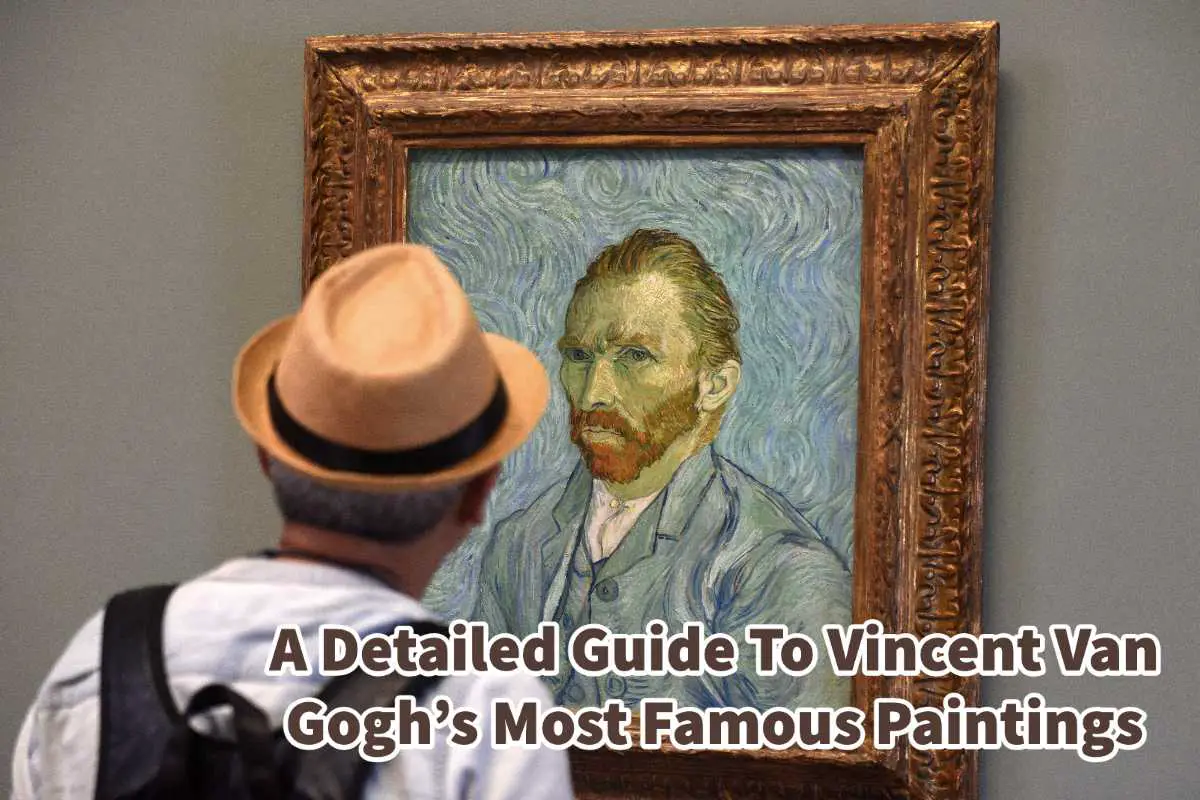When I think of Vincent van Gogh, it is hard for me to pick out what I consider to be his most famous or top paintings. He is a great artist, and so many paintings inspire many people.
Vincent van Gogh was a prolific artist, and we are lucky he had so much of his artwork survive over the centuries. He is considered one of the most famous painters of all time, and his work has been celebrated and admired by art lovers for years. The paintings we have picked out are considered by many to be his masterpieces.
Table of Contents
- Detailed Guide To Vincent Van Gogh’s Most Famous Paintings
- The Starry Night (1889) By Vincent Van Gogh
- The Yellow House (1888) By Vincent Van Gogh
- Bedroom In Arles (1889) By Vincent Van Gogh
- The Bedroom (1889) By Vincent Van Gogh
- Vase With Fifteen Sunflowers (1890) By Vincent Van Gogh
- Sunflowers (1888) By Vincent Van Gogh
- Wheatfield With Crows (1890) By Vincent Van Gogh
- Almond Blossoms (1888-1890) By Vincent Van Gogh
- Irises (1889) By Vincent Van Gogh
- Wheatfield With Cypresses (1889) By Vincent Van Gogh
- Van Gogh Self Portrait (1888) By Vincent Van Gogh
- The Potato Eaters (1885) By Vincent Van Gogh
- Café Terrace At Night (1888) By Vincent Van Gogh
- The Night Café (1888) By Vincent Van Gogh
- Portrait Of The Postman (1888) By Vincent Van Gogh
- Portrait Of Dr. Gachet (1890) By Vincent Van Gogh
- Self-Portrait With Bandaged Ear (1889) By Vincent Van Gogh
- At Eternity’s Gate (1890) By Vincent Van Gogh
- Starry Night Over The Rhône (1888) By Vincent Van Gogh
- Related Questions
Detailed Guide To Vincent Van Gogh’s Most Famous Paintings
It isn’t easy to pick out the most famous paintings by an artist so well known and respected today as Vincent van Gogh. For centuries, art lovers and artists have been inspired by his paintings and his use of color,, and artistic technique.
So much of his artwork is considered to be a masterpiece. So we have picked out what we believe to be some of his top paintings. We will discuss a bit about the history and the meaning behind them and why we believe them some of his most famous paintings.
The Starry Night (1889) By Vincent Van Gogh
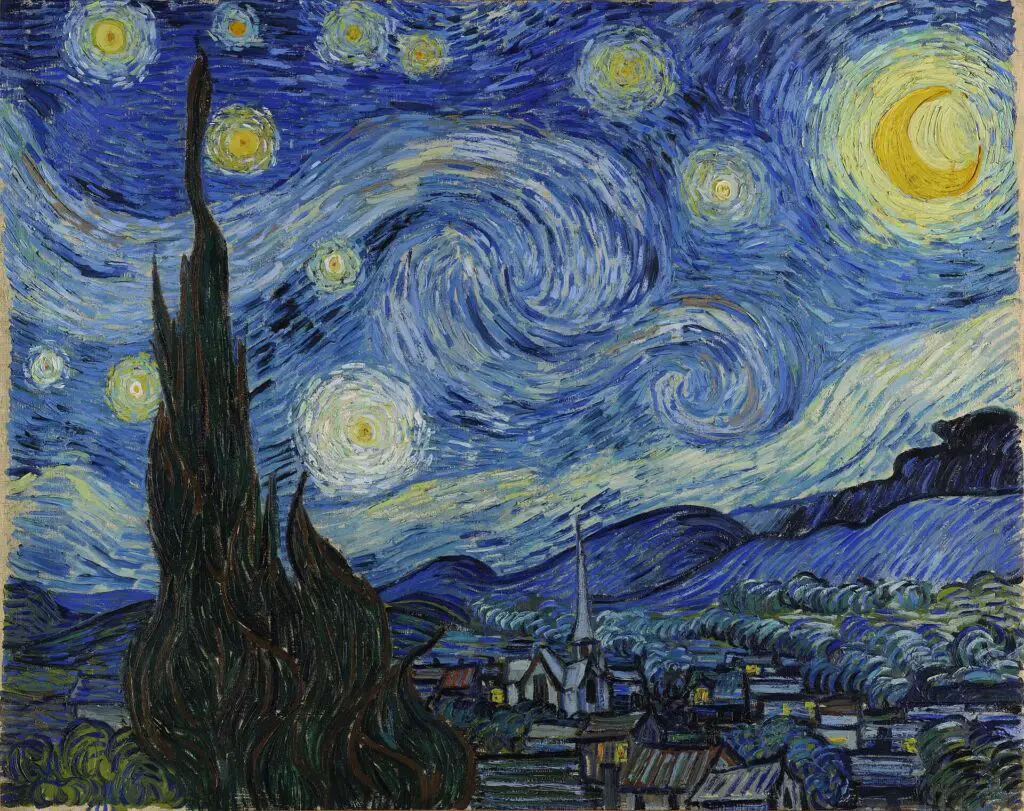
Without a doubt, one of Vincent van Gogh’s most recognizable and beloved pieces of artwork is Starry Night. The starry night depicts a nighttime sky with stars and a crescent moon.
Vincent van Gogh described it as “an infinite, starry sky.” The work captured his emotional state when he struggled with mental health issues at the asylum.
It is also a painting filled with many symbolism of his life. An example would be the steeple of the church, which many said is a steeple of a church from Holland, not France.
Click here to read our blog to learn more about the Starry Night painting.
The Yellow House (1888) By Vincent Van Gogh
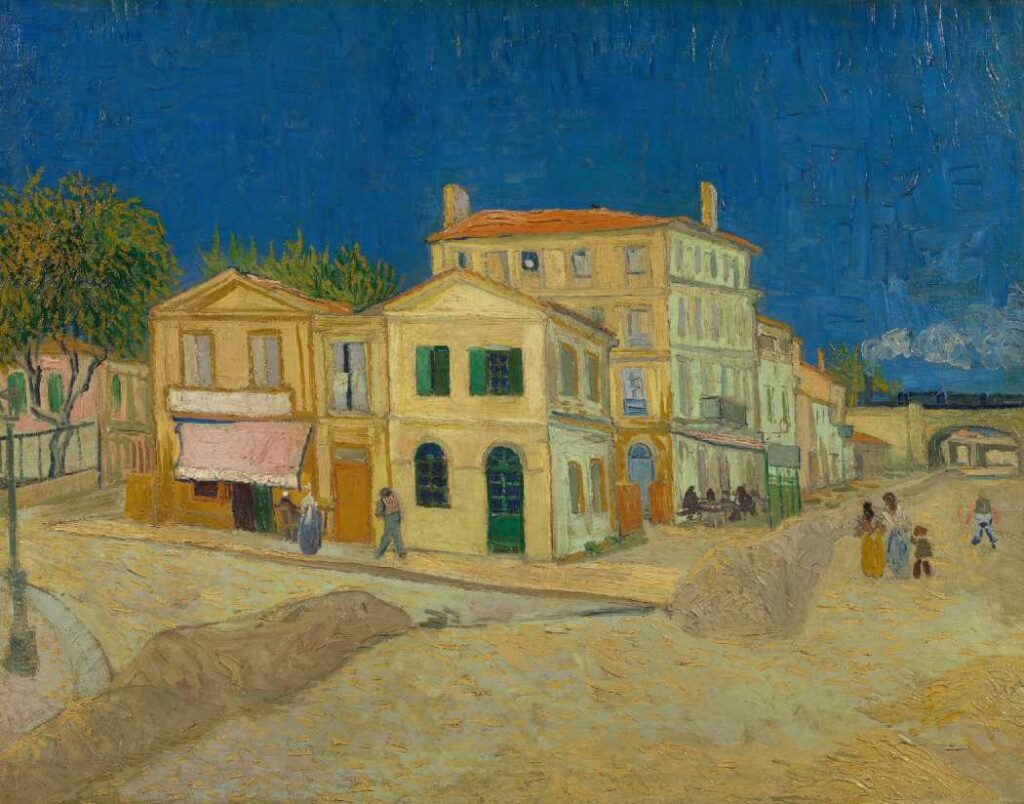
The Yellow House is another iconic painting that many recognize. The Yellow House was the home of Vincent Van Gogh and his friend, Paul Gauguin.
The two artists, no doubt, had some happy times in the house; there was also some strife and contention. While living in this house, Vincent van Gogh famously cut off his ear and ended up in a mental asylum.
The painting shows this Yellow House with a yellow façade, the street he lived on, and green shutters. It offers a typical scene of a home in the south of France where Van Gogh was living.
Click here to read our blog to learn more about the Yellow House.
Bedroom In Arles (1889) By Vincent Van Gogh
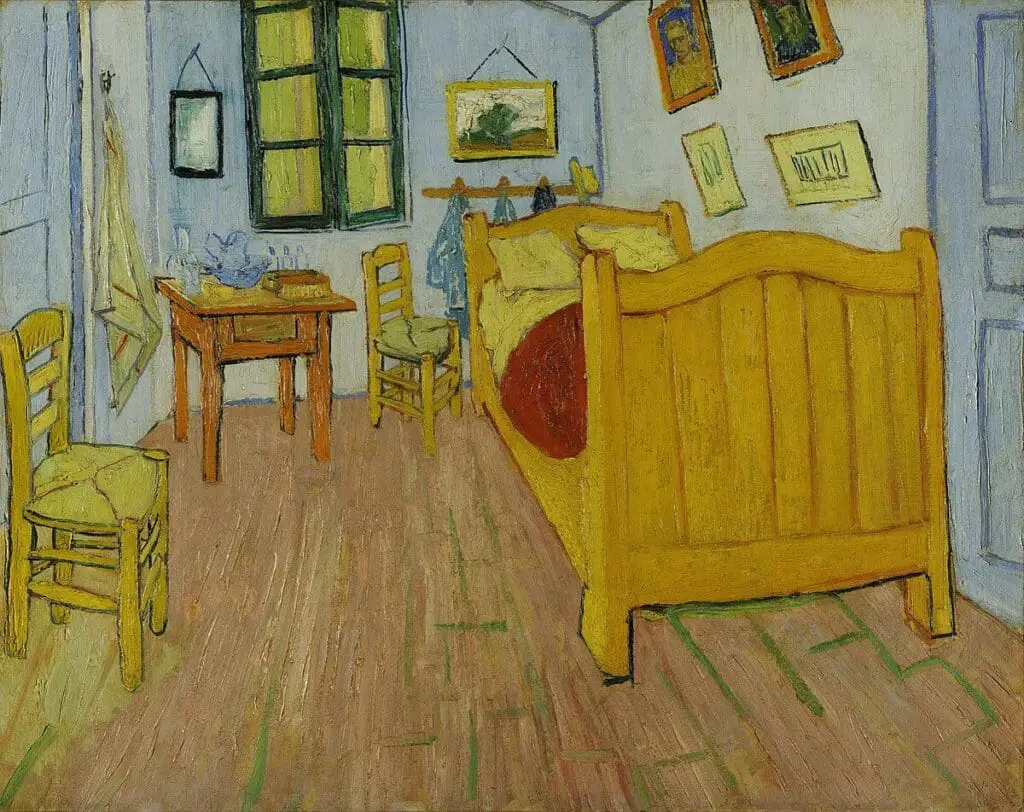
The Bedroom in Arles depicts a bedroom In Van Gogh’s yellow house. It shows a simple room with a bed and two chairs adorned with walls and shutters.
This unique perspective on this bedroom shows his influence from Japanese woodblock prints. This bedroom scene is one of three of his bedroom he would eventually paint.
You can read our blog by clicking here to learn more about his bedroom paintings.
The Bedroom (1889) By Vincent Van Gogh
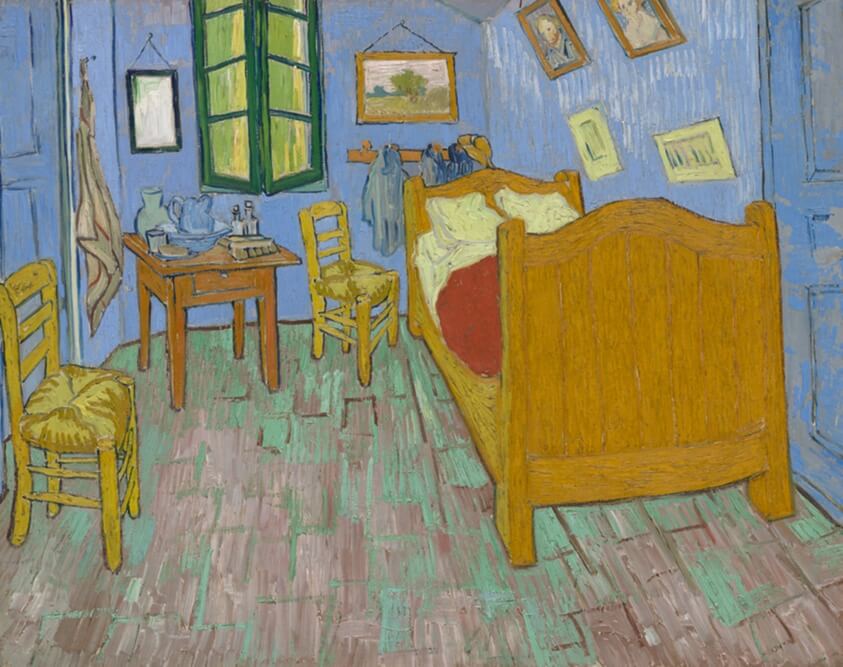
The Bedroom is another painting of the bedroom in the Yellow House in Arles, France. Like the other paintings, this bedroom shows a room he prepared with simple furniture and artwork on the wall.
We know from these paintings that he loves his bedroom as he paints this scene at least three times.
By clicking here, you can find out more about Van Gogh’s Bedroom paintings by reading our blog About Vincent Van Gogh’s 3 Yellow Bedroom Paintings.
Vase With Fifteen Sunflowers (1890) By Vincent Van Gogh

Van Gogh was known to love flowers and paint many different floral works. The Vase With Fifteen Flowers is considered one of his more beautiful flower paintings.
Sunflowers (1888) By Vincent Van Gogh

Van Gogh painted several sunflower paintings. These were known to be some of the favorite paintings of Jo van Gogh,- Bonger,, his sister-in-law.
These iconic works of sunflowers arranged in a vase are one of the world’s most recognizable van Gogh pieces of art. To him, the sunflowers and the yellow colors help to symbolize beauty, optimism, and joy. Click here to learn more about Vincent Van Gogh’s Sunflower Paintings – In His Own Words.
Wheatfield With Crows (1890) By Vincent Van Gogh
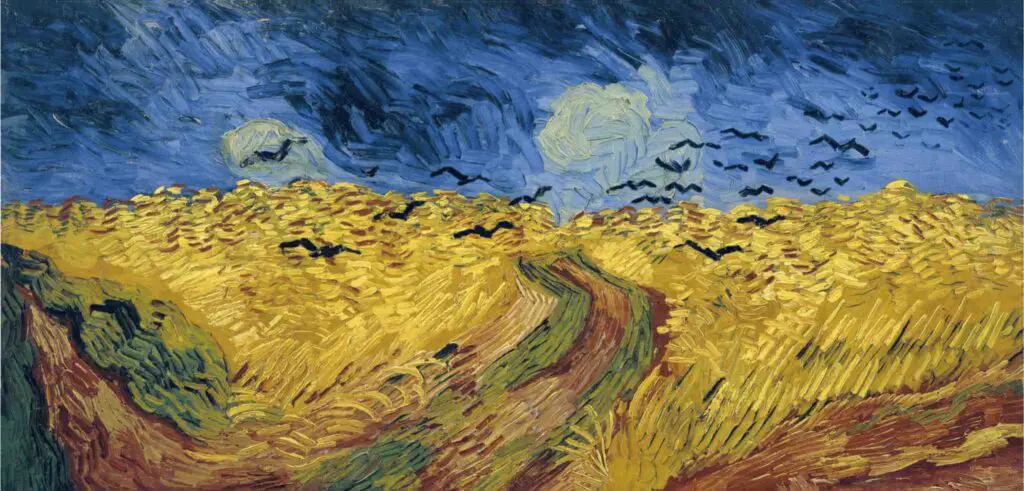
Several critics have cited the Wheatfield With Crows as one of Van Gogh’s most significant works of art. It is thought to also be one of his final paintings before his untimely death in July 1890.
The painting shows a wheatfield and then several crows flying overhead. Many feel the crows conveyed Van Gogh’s feeling of deep despair during this period in his life.
Almond Blossoms (1888-1890) By Vincent Van Gogh
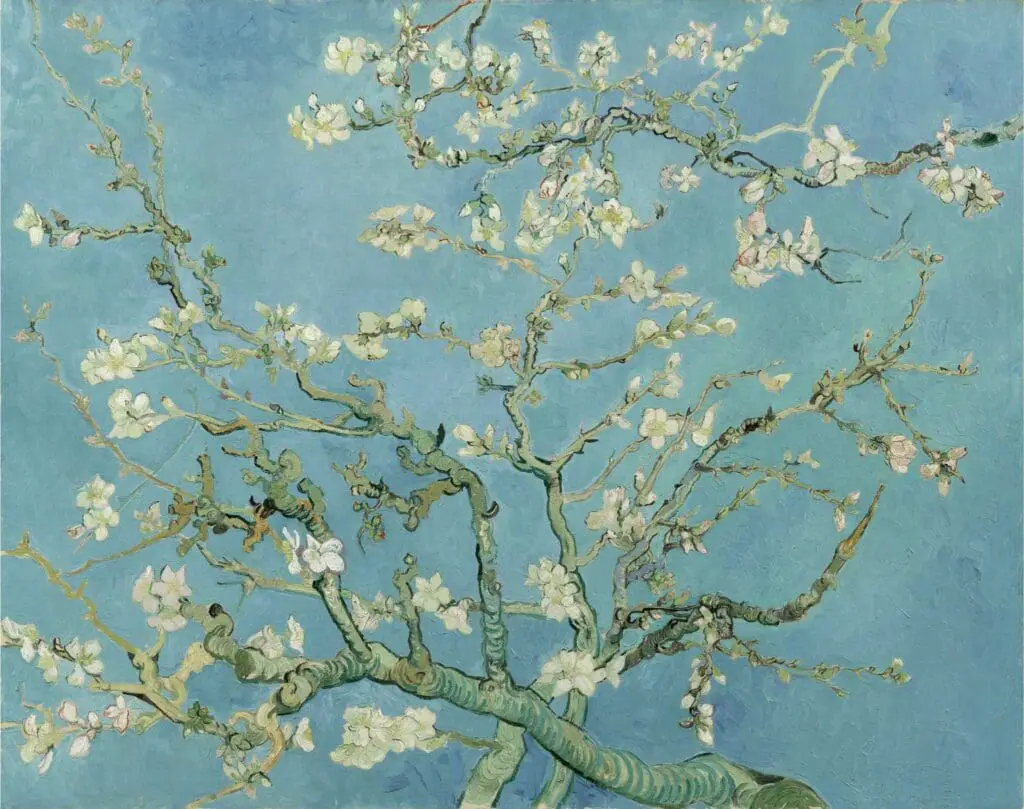
Almond Blossoms is probably one of my favorite Van Gogh paintings. You can see that this painting os influenced by the Japanese woodblock print art. The painting has a very Japanese or Asian feel.
The painting was painted for his nephew, Vincent Williem was was sent to his brother Theo and his wife Jo to celebrate his nephew’s birth in 1890. The apple blossoms were known to represent new life and hope.
By clicking here, you can find out more by reading our blog about Van Gogh’s Almond Blossoms.
Irises (1889) By Vincent Van Gogh
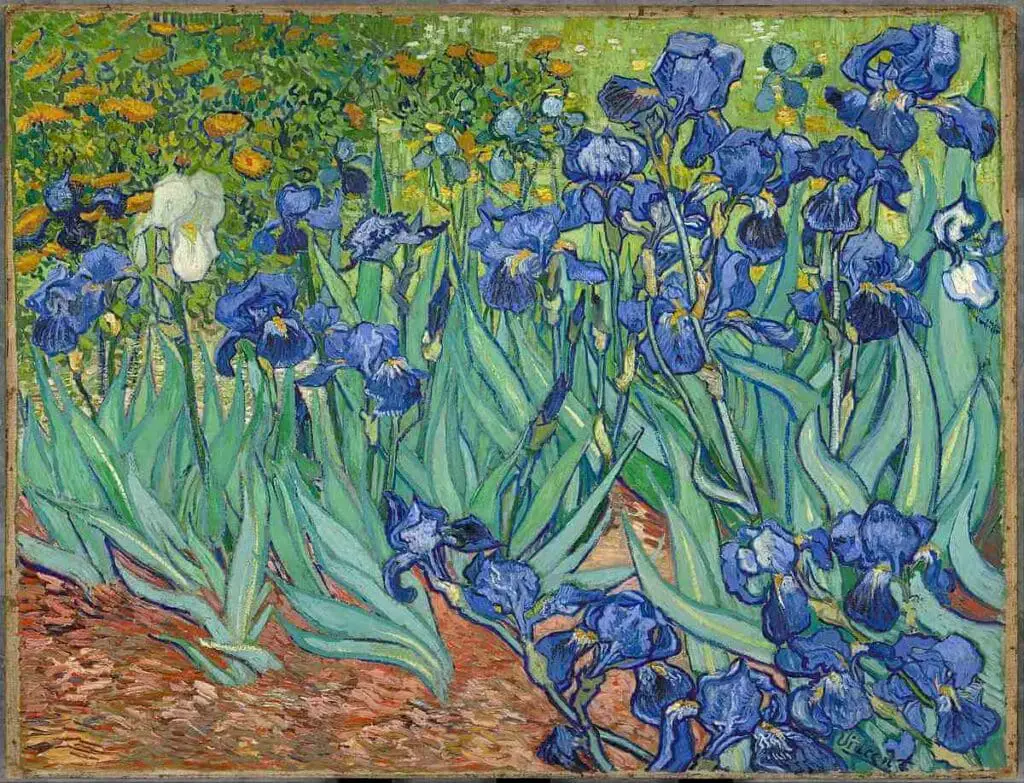
The irises are a beautiful painting that shows the landscape with Iris flowers blooming in the foreground. The painting captures van Gogh’s appreciation for nature, beauty and his fascination with Japanese woodblock prints.
This is such a beautiful painting that it continues to be one of the most famous van Gogh paintings he created.
Wheatfield With Cypresses (1889) By Vincent Van Gogh
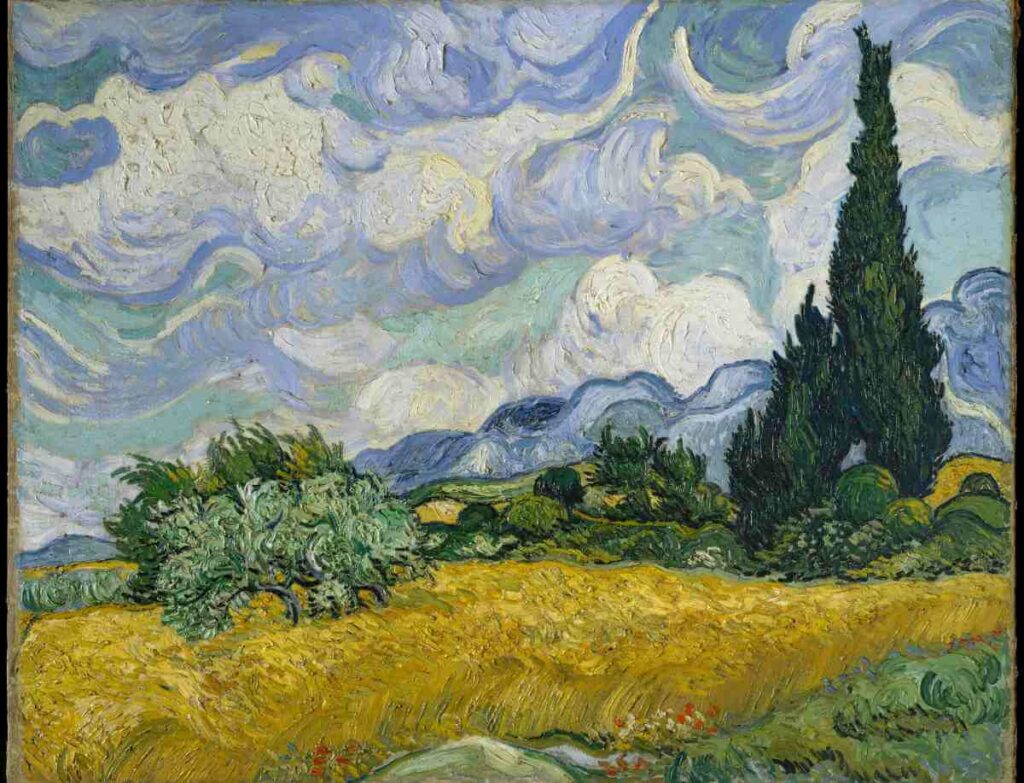
It was in 1889 that Van Gogh started to devote a lot of his time to painting cypresses. This painting is an example of him painting the cypress trees with the Wheatfield in the foreground.
This Wheatfield With Cypresses is considered one of his best summer landscape paintings. He has some magnificent colors and shows some great clouds in the background.
Van Gogh Self Portrait (1888) By Vincent Van Gogh

Van Gogh was known to paint many self-portraits. There are over 35 self-portraits by Vincent van Gogh and only one photo of him.
One of his more iconic self-portraits is this 1888 self-portrait of Vincnet Van Gogh in a straw hat and smoking a pipe.
The Potato Eaters (1885) By Vincent Van Gogh
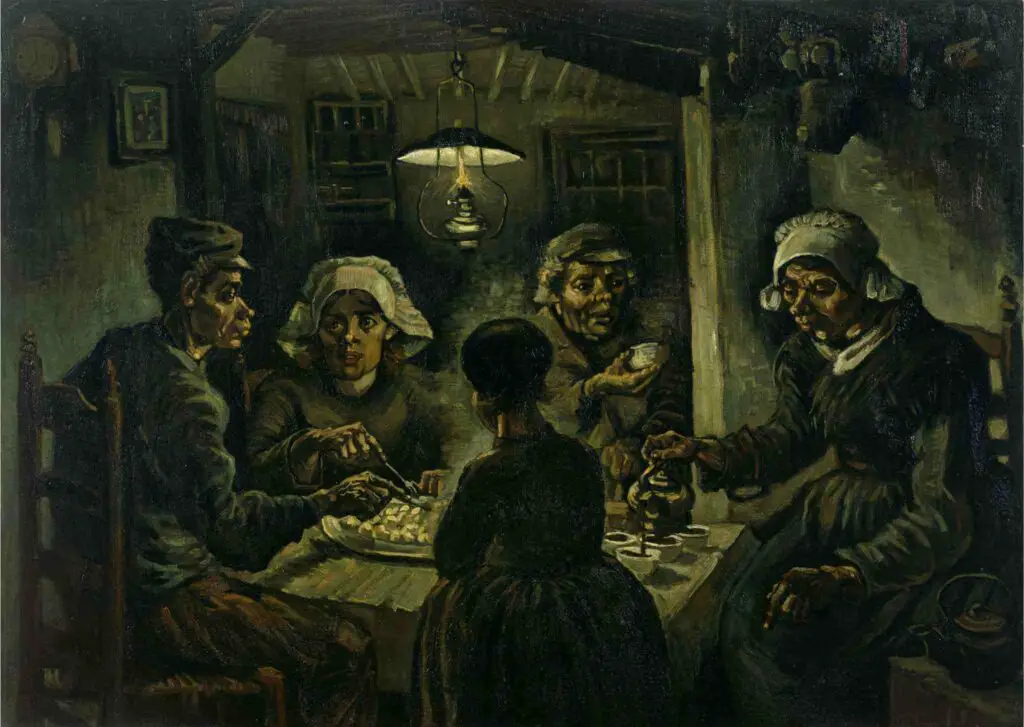
The Potato Eaters are one of van Gogh’s earlier works. The painting shows a group of peasants eating potatoes around the table.
The work shows appreciation for the simple life and its close-knit community of the peasants, but it also shows some of the harsh realities of country life that many peasants needed to face during this time.
Café Terrace At Night (1888) By Vincent Van Gogh

The Café Terrace at night is a painting of a café in an alley with people enjoying their drinks outside. This painting clearly shows Van Gogh’s appreciation for the nightlife in France. It also shows his great ability to be able to capture scenes from everyday life.
One thing that makes this painting unique is that it was the first of a series of paintings that used starry night backgrounds. This painting was created before he painted his famous The Starry Night painting.
The Night Café (1888) By Vincent Van Gogh
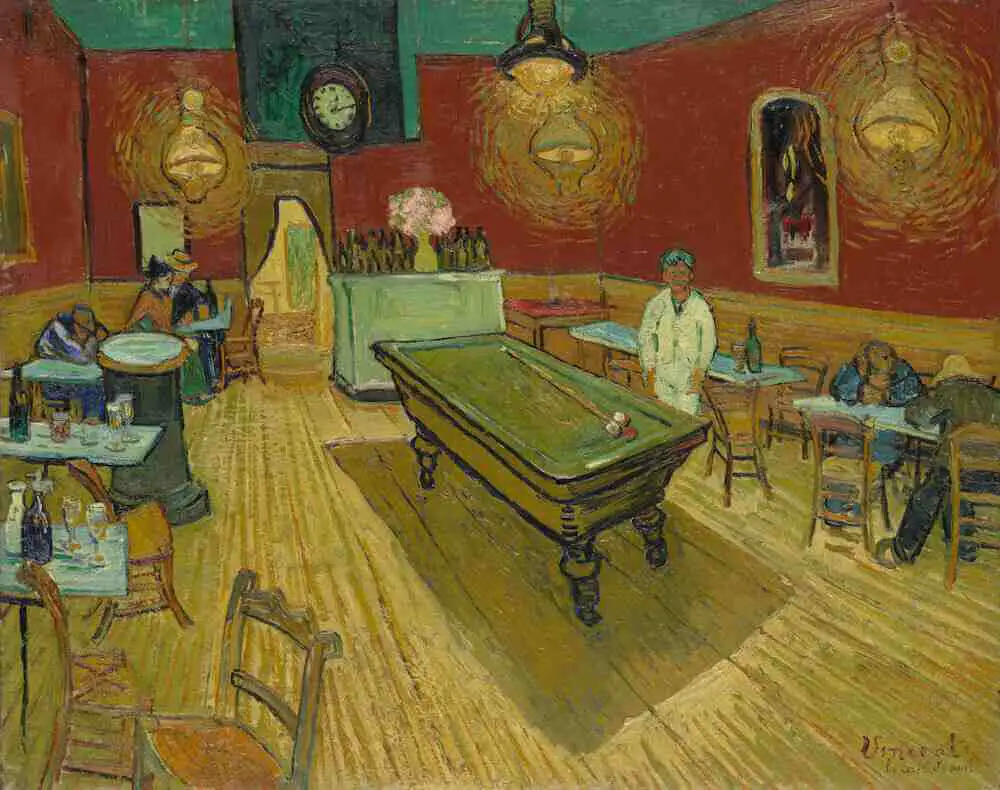
The Night Café is another painting showing France’s nightlife scenes during this time. In this café, there are very few customers; Van Gogh said many of the customers were drunks.
This painting of the Night Café gives us great insight into the nightlife in France. We can see the decoration of a typical French café during this time in France.
Portrait Of The Postman (1888) By Vincent Van Gogh

The Portrait Of The Postman was a picture of one of van Gogh’s good friends, Joseph Roulin. The painting is a tribute to him, his friendship, and Van Gogh’s admiration for his dear friend, the postman.
Van Gogh painted the postman several times; he put in some fancy backgrounds with flowers and others and not just plain backgrounds. We can see that he loved the subject matter of painting his dear friend, Joseph Roulin.
If you’d like to learn more about Joseph Roulin and his paintings by vVan Gogh, you can read our blog about Van Gogh’s Postman – His Friend Joseph Roulin by clicking here.
Portrait Of Dr. Gachet (1890) By Vincent Van Gogh
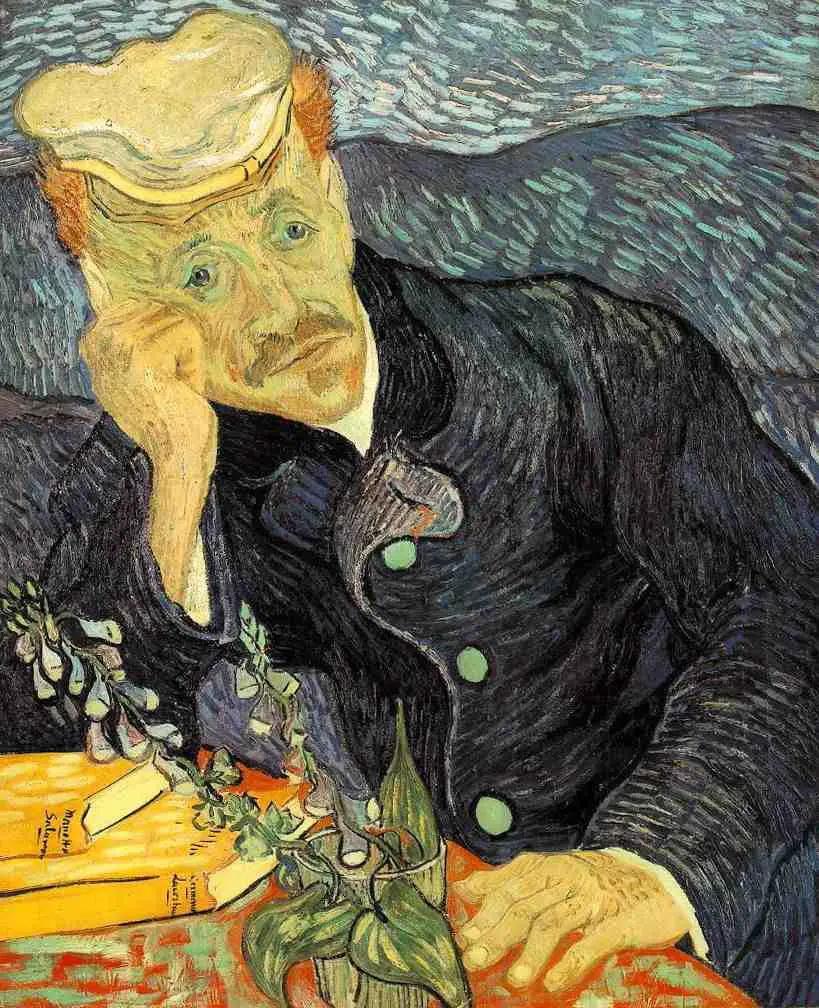
The Portrait of Dr. Gachet is one of the most revered paintings by Vincent Van Gogh. This painting depicts Dr. Gachet, a homeopathic doctor with whom the artist was treated by when he was at the asylum.
Dr. Gachet took care of Van Gogh, and it was said they became close friends throughout his treatment oat the asylum.
Self-Portrait With Bandaged Ear (1889) By Vincent Van Gogh

Perhaps there’s no other Van Gogh painting as truthful and honest, then the painting of his self-portrait with the bandaged ear. This shows us a lot about Van Gogh that he was not afraid to paint a picture of himself, even during his darkest hours when he had cut off his ear.
To me, the painting shows his anguish and despair because he cut off his ear and his resilience in the face of this adversity to try to beat his mental illness.
At Eternity’s Gate (1890) By Vincent Van Gogh

At Eternity’s Gate is a painting showing an image of total despair. It demonstrates that even in his darkest moments of sorrow and pain Van Gogh clung to the faith of God and eternity as he named the picture in English as it At Eternity’s Gate.
The painting also reflects Van Gogh’s desire to find peace from his struggles and mental health issues.
Starry Night Over The Rhône (1888) By Vincent Van Gogh
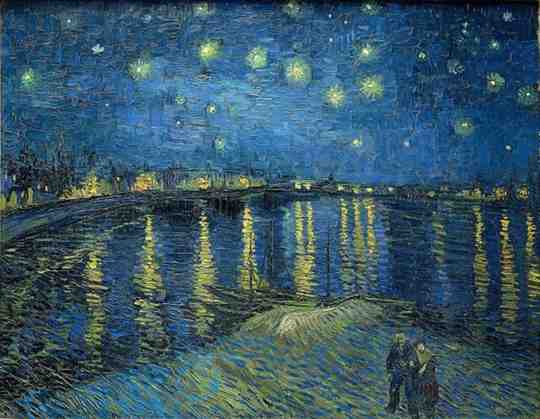
The Starry Night over the Rhône is another painting that shows the night sky and Van Gogh’s fascination with the nighttime as a subject matter. Van Gogh loved the challenge to paint at night and this meeting is a sample of Van Gogh painting at night.
Van Gogh is one of the most crucial artists that ever lived. These works of art are some of his most iconic and beloved works. Each painting also reflects upon a particular period of his life and conveys his appreciation for beauty, nature, loneliness, despair, resilience, friendship, and hope.
It is because of this that his paintings continue to remain an inspiration to artists and art lovers around the world.
Anita Louise Art is dedicated to art education, great artists, and inspiring others to find and create their art. We love art that uplifts and inspires. #ArtToMakeYouSmile! #ArtToMakeYouHappy!
If you are interested to see any of my art, you can find out more by clicking here. If you are interested in what inspires me and my paintings, you can discover more by clicking here.
We have a free newsletter and would love you to be part of our community; you can subscribe to the newsletter by clicking here. If you have any questions, I would be happy to talk to you anytime. You can reach me, Anita, by clicking here.
Subscribe to our Anita Louise Art YouTube Channel with great videos and information by clicking here.
Join us for our podcast “5 Minutes With Art.” Spend just 5 minutes a week with us to discover and learn about great art and artists. You can find out more about our podcast by clicking here.
Related Questions
Immersive Van Gogh Exhibit – Taking Photos And Other Tips
Before we entered the Immersive van Gogh Exhibit, the girl checking our ticket told us that photos were allowed and encouraged, but she added that flash photography was not allowed. While at the exhibit, I took a lot of pictures and saw a lot of other people also taking photos.
By clicking here, you can discover more by reading Immersive Van Gogh Exhibit – Taking Photos And Other Tips.
Similarities Of Claude Debussy And Claude Monet
Claude Debussy is a musical composer. Claude Monet is an artist. They are both considered Impressionists and were not afraid to break from the tradition of their day to create something new. Both Debussy and Monet greatly influenced many artists that went after them.
By clicking here, you can learn more by reading Similarities Of Claude Debussy And Claude Monet.
What Are Some Japanese Woodblock Print Characteristics?
There are many characteristics of a Japanese woodblock print, from the woodblock print title, artist name, and publisher’s seal; other features also include the color and subject matter. Japanese woodblock prints also have different artistic art movements.
By clicking here, you can learn more by reading What Are Some Japanese Woodblock Print Characteristics?.

